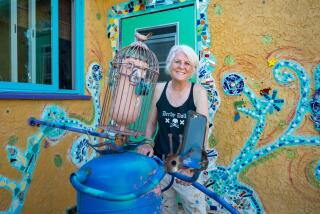Gallery Owner Gets Burned by Toaster Law : Art: Small shop dealing in electric sculptures closes after city inspectors order tests that are usually applied to appliances like TV sets and heating pads.
- Share via
Greg Moul’s small art gallery in Venice is filled with neon sculptures worth thousands of dollars each, but it was a law dealing with lowly toasters and television sets that pulled the plug on his pricey objets d’art .
Called See the Light, the gallery displays the upscale work of Southern California sculptors who incorporate incandescent light or other kinds of illumination in their art: holography, neon sculptures and one-of-a-kind light fixtures and lamps.
From the very beginning, Moul said, business had been good--that is until trouble stuck early in November, just as Christmas holiday shopping was getting under way.
It was then that an electrical inspection team from the Los Angeles City Department of Building and Safety ordered Moul to have every piece of art in the gallery safety tested and approved by the city’s testing lab. If he failed to comply, he would be hauled before the city attorney, he was warned.
City inspectors cited a law that was designed to protect consumers from buying faulty toasters, television sets and light fixtures. The catch: each inspection would cost $770.
The art community howled in protest, the city held firm, and Moul--citing the cost--was forced to voluntarily close his store.
“It’s just ridiculous,” said Mary Carter, curator of the nonprofit Museum of Neon Art in Los Angeles, where she said works of art have never been inspected.
Located in an old blue house on a funky street lined with craft, art and antique shops, the gallery attracts customers from as far as Malibu and the Palos Verdes Peninsula. Art experts say that the gallery is on the cutting edge of a new artistic wave called “functional art.”
Other than failing to have the art inspected, the inspectors found nothing wrong in the gallery, Moul said.
“I had no choice (but to close),” said Moul, 32. “I don’t want to break the law.”
Moul’s customers, to say the least, were shocked.
“It’s crazy,” said Joe Alfen, a South Bay auto dealer who had purchased several pieces for his Rancho Palos Verdes home and came back to find the gallery closed. “I can’t believe it. . . . They’re really putting him out of business.”
What happened was that functional art had run afoul of an obscure manufacturing safety code that few Southern California artists, museums, designers or gallery owners had ever heard of or complied with, according to experts.
The code requires a manufacturer to submit for testing a prototype of every toaster, heating pad or lamp that is to be produced. The tests and certificate of approval must be obtained before the product can be displayed. No exceptions are made for artwork, officials said.
Department officials acknowledged that the crackdown on an art gallery is unusual. They normally make random inspections of manufacturers and retail outlets, but happened across See the Light, thinking it was just another lighting shop.
“We haven’t seen anything like (the gallery) before,” said senior inspector Charles Brown. However, he added, the safety laws must be enforced. He couldn’t recall having inspected other galleries or museums.
Nevertheless, the move sent shock waves through the newly emerging world of functional art.
“The problem with functional art is that people don’t know how to identify it,” said Lois Lambert, who opened the Gallery of Functional Art in Santa Monica nearly four years ago. Functional art is just that, she said: functional. It can be a chair, a table, a bowl or some form of light.
“Savvy people know what functional art is about but the bureaucrats don’t seem to know. They have a law that says you need (testing) and that’s that,” Lambert said.
While safety is a legitimate concern, many artists and gallery owners complain that commercial testing standards should not be applied to works of art. A factory can spread the $770 cost of a test cost for a new toaster over thousands of toasters, while an artist can’t do that with an original work, they said.
But Bahzad Eghtesady, director of the city’s electrical testing laboratory, warned that the introduction of electricity in any work of art could cause serious safety problems.
Improper wiring or uninspected parts “could start a fire or electrocute somebody,” Eghtesady said.
Moul appealed to Councilwoman Ruth Galanter. Galanter, whose district includes Venice, backed the inspector’s decision, saying that in case of a fire started by an unapproved work, “We would all be responsible for allowing such a product to be marketed in violation of existing safety regulations.”
Meanwhile, See the Light remains closed--unless city inspectors change their minds or find some way of exempting galleries from the regulations.
“I’d like that, but I’m not holding out much hope,” Moul said.
More to Read
The biggest entertainment stories
Get our big stories about Hollywood, film, television, music, arts, culture and more right in your inbox as soon as they publish.
You may occasionally receive promotional content from the Los Angeles Times.










